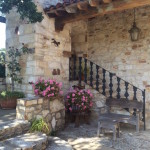This year Passover took a whole new meaning in my house. For one thing, it’s the first time my children have ever kept the holiday’s strict dietary rules. In prior years, I felt they were too young for me to change their dietary habits and I couldn’t get them to eat enough Passover food to keep them going. This year I decided that at ages 8 and 9, they could survive a week without bread, pasta and rice. For another thing, going to Hebrew School twice a year seems to be paying off. This is the first time they were genuinely excited to sit down at the table for Seder without clamoring for food during the service. It made a big difference having their undivided attention.
At the first seder, we went to a friend’s house who keeps the holiday very traditionally and by the book. We read from the Hagaddah in Hebrew and English and didn’t miss out one word. As soon as my children realized they could participate in the service and read long passages about the Jew’s exodus from Egypt, the evening took on a dimension. They didn’t harp over the length of the service nor did they complain about the long wait until the meal was served. For the first time since I had children, I could focus on the story, on the food, on the meaning of the holiday.
The second day took a very different dimension. Not only did my kids hit the super market to buy the ingredients for dinner, but they spent hours in the kitchen with me preparing the food. When it came time to lay down the table, they took care in setting up the seder plate and making sure there were bowls of salt water and horseradish out. At the evening’s start, there was some commotion over my new Hagaddah, purchased a few days prior. My son, who likes routine (nothing can ever change), expected the service to be just the one the night before, but I put my foot down and declared that our service would be slightly different. We were using a new hagaddah called “A Family Hagaddah” by Shoshana Silberman. It featured the traditional service but there were helpful side notes and questions that broke the story into simple terms and asked pertinent questions to bring the story into modern times. For example, when we broke the afikomen, we read how we were setting matzo aside as a symbol of hope for all those in the world who live in poverty, disease, tyranny and violence. When we talked about Pharoh and freedom, we talked about slavery and freedom today and how they are defined and where they exist. It was exhilarating to hear the insightful answers that came out of my children’s mouths. We also brought women more into the service and read how we were not only welcoming Elijah, the prophet, but also Miriam. who we put a cup out for. Her cup represents the living waters that sustained the jewish people after they left Egypt. She will guide us on our journey to repair the world. That was a very beautiful and moving part of the service and full of girl power. When we spoke about Passover at the Bergen-Belsen concentration camp in 1944 when Rabbis decreed that chametz (bread) could be eaten so not to endanger the inmate’s live, provided that a specific prayer was read. As we read the prayer (“And ye shall live by my commandments and not die by them,” I flinched and worried about the effect of the words on my children. But my daughter looked at me firmly when I read it and said, “I know about Anne Frank. I know what happened.”
As a result of this increased interest in the holiday, I upped the anty in the kitchen this year, and I’ve cooked more this week than I have all year, churning out traditional recipes like brisket, sweet & sour meatballs, matzo pizza, chocolate matzo and more. Another book that made a huge difference in our holiday was one that my daughter stumbled upon while we were working in the kitchen, Get Cooking! A jewish American Family Cookbook by Rachel Harkham and Doni Zasloff Thomas. The book infuses cooking with Jewish values and offers simple recipes to get kids and parents cooking together. Doni Zasloff Harkham, an American singer known as Mama Doni, and Recipe Rachel, a cookbook author, have come together to write this book full of recipes from around the world. The result is food that is uniquely Jewish and American, and my kids have already chosen a dozen things for us to make. It’s divided into sections from Rosh Hashanah to Thanksgiving to Chanukah to the Fourth of July and offers food to celebrate and try (great for picky eaters). It’s also filled with sing-alongs and snippets that make the food meaningful. We’ve already made the sweet & sour zeroa chicken wings and matzo pizza, which were BIG hits in my house and I’m looking so forward to exploring my culinary skills which have been dormant for some time in the days beyond Passover.
And for the first time ever, both my children tried to read Hebrew. That was a moment I’d been waiting for and the readings were like music to my ears.
To me, this has been a different Passover than ever before. And I’ll take it.









 Follow
Follow





I loved reading this post. It made my day..
How wonderful, Holly! Yes, having older children who can participate makes the holiday even more precious. Just wait until they are teenagers and running it for you!!
Oy vey, Hadass!
I love this post, Holly. Passover to me is the holiday I feel my kids can get the most invested in, not because of gifts or sweets. My 7-year-old read the four questions in English this year. It was amazing to hear because she is not doing it from memorization, it represents all she has learned this year both in religious school and in secular school. Next year, Hebrew and English!
Absolutely! Thanks for stopping by, Laura.
What a beautiful experience and a beautiful way to start off the holiday. Many wishes for a healthy and happy to you and yours.
Same to you, Andrea.
Chag Sameach! I love the “Get Cooking” cookbook, too. Not just for the recipes, but so many great ideas for celebrating.
I will look for that cookbook, Anna.
So moved by this, Holly! Beautiful piece, and good work.
You are the best, Aliza.